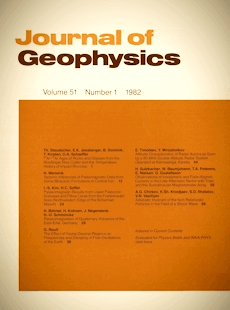Tectonic inferences of paleomagnetic data from some Mesozoic formations in Central Iran
Article Sidebar

Vols. 1-18 (1924-1944), ISSN 0044-2801
Main Article Content
Abstract
Material for paleomagnetic research has been collected from sedimentary rocks of Mesozoic age from four localities in Central Iran. Detailed paleomagnetic analyses have been carried out using partial progressive demagnetization procedures both with alternating magnetic fields and with heating in order to isolate the characteristic remanence. The following results were obtained: Early Triassic Sorkh Shales with D = 289°, I = 21°, α95= 14°; Late Jurassic Garedu Red Beds with D = 4°, I = 42°, α95 = 14°; Late Jurassic - Early Cretaceous Bidou Beds with D = 48°, I = 32.5°, α95 = 19°; Middle Cretaceous Dehuk Sandstones with D = 326°, I = 38.5°, α95 = 21°. The large α95 values are due to the rather small collections of specimens, roughly 50 each. From the paleomagnetic data we conclude that in Early Triassic times Central Iran, which forms part of the Iranian-Afghan micro-continent, belonged to Gondwana; since Early Jurassic times the area has been positioned close to the Eurasian continent. The scatter in the declination of the remanence directions can be explained in terms of rotations of individual blocks along the main Central-Iranian fault systems.
 ARK: https://n2t.net/ark:/88439/y021734
ARK: https://n2t.net/ark:/88439/y021734
Permalink: https://geophysicsjournal.com/article/264
Article Details
References
Bratash, V.I. (1975) Kerman - Kashmertrough, Iran and the problem of the junction between pre-Jurassic structures of the Turonian plate and the Mediterranean belt. Geotectonics (Engl. ed.) 9:101-107
Burek, P.J. (1967) Korrelation invers magnetisierter Gesteinsfolgen im Buntsandstein (Trias) in SW-Deutschland und Frankreich. Geol. Jahrb. 84:591-616
Dankers, P.H.M., Zijderveld, J.D.A. (1981) Alternating field demagnetization of rocks, and the problem of gyromagnetic remanence. Earth Planet. Sci. Lett. 53:89-92
Fisher, R.A. (1953) Dispersion on a sphere. Proc. R. Soc. London, Ser. A 217:295-305
Huckriede, R., Kursten, M., Venzlaff, H. (1962) Zur Geologie des Gebietes zwischen Kerman und Sagand (Iran). Geol Jahrb. B 51, 198 pp.
Irving, E. (1977) Drift of the major continental blocks since the Devonian. Nature 270:304-309
Krumsiek, K. (1976) Bewegung der Iranisch-Afghanischen Platte. Geol. Rundschau 65:909-929
Krumsiek, K. (1980) Zur plattentektonischen Entwicklung des Indo-Iranischen Raumes (Resultate palaomagnetischer Untersuchungen in Afghanistan). Geotekt. Forsch. 60, l-11:1-223
Kursten, M. (1980) Zur geodynamischen Entwicklung des Iran, ein Beispiel interkratonischer struktureller Vorgange. Geol. Rundsch. 69:22-40
Roy, J.L., Lapointe, P.L. (1978) Multiphase magnetizations: problems and implications. Phys. Earth Planet. Int. 16:20-37
Ruttner, A., Nabavi, M.H., Hajian, I. (1968) Geology of the Shirgesht area (Tabas area, East Iran). Geol. Surv. Iran Rept. 4, 133 pp.
Smith, A.G., Hurley, A.M., Briden, J.C. (1981) Phanerozoic paleocontinental world maps. Cambridge University Press
Soffel, H., Forster, H., Becker, H. (1975) Preliminary polar wander path of Central Iran. J. Geophys. 41:541-543
Soffel, H.C., Forster, H.G. (1980) Apparent polar wander path of Central Iran and its geotectonic interpretation. J. Geomagn. Geoelectr. 32, suppl. III:117-135
Soffel, H.C., Forster, H.G. (1982) Polar wander path of the Central Iran Microplate including new results. N. Jahrb. Geol. Palaontol. Monatshefte (In press)
Stocklin, J., Eftekhar-nezhad, J., Husmand-zadeh, A. (1965) Geology of the Shotori Range (Tabas area, East Iran). Geol. Survey Iran Report 3, 90 pp.
Stocklin, J. (1968) Structural history and tectonics of Iran: a review. Am. Ass. Petrol. Geol. Bull. 52:1229-1258
Stocklin, J. (1974) Possible ancient continental margins in Iran. In: The Geology of Continental Margins, A. Burke and C.L. Drake, eds: pp. 873-887. Springer, Berlin-Heidelberg-New York
Wensink, H., Zijderveld, J.D.A., Varekamp, J.C. (1978) Paleomagnetism and ore mineralogy of some basalts of the Geirud Formation of Late Devonian - Early Carboniferous age from the southern Alborz,
Iran. Earth Planet. Sci. Lett. 41:441-450
Wensink, H. (1979) Implications of some paleomagnetic data from Iran for its structural history. Geologie en Mijnbouw 58:175-185
Wensink, H., Varekamp, J.C. (1980) Paleomagnetism of basalts from Alborz: Iran part of Asia in the Cretaceous. Tectonophysics 68:113-129
Zijderveld, J.D.A. (1975) Paleomagnetism of the Esterel rocks. Krips Repro Meppel, 199 pp.











